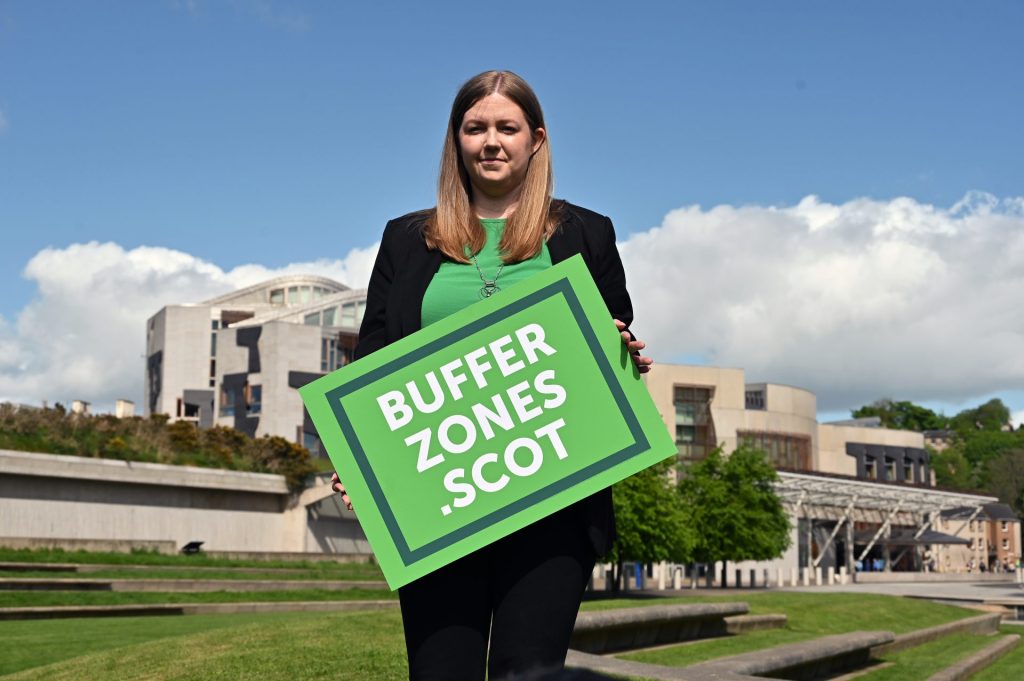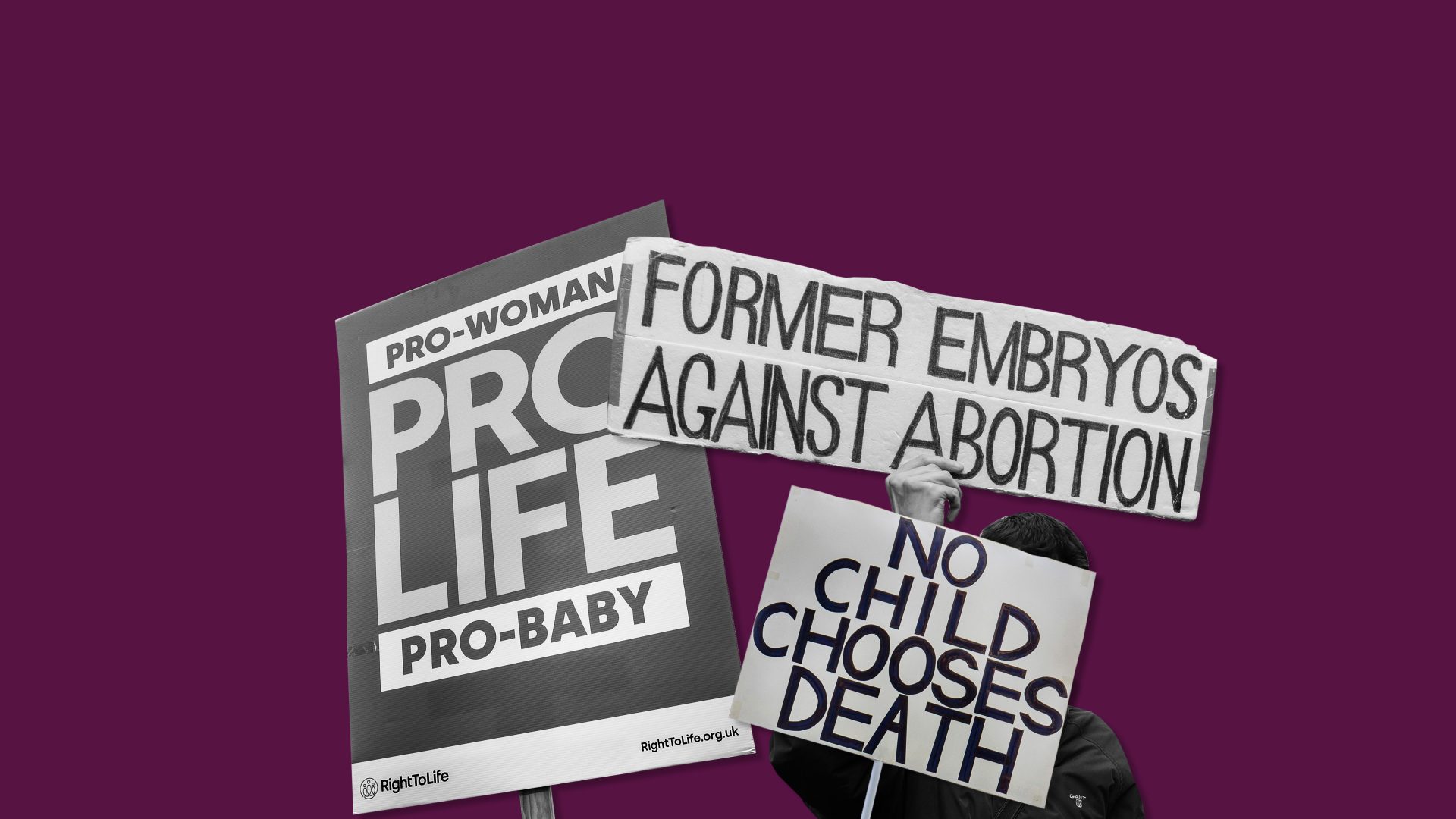It’s a tale as old as time. Once again, another obstacle is obstructing women’s access to abortion services. Except, on this occasion, it’s more literal. Across the UK, there has been a stark rise in anti-choice protests outside abortion clinics and people blocking the entrances. The numbers speak for themselves.
According to the British Pregnancy Advisory Service (BPAS), Since 2018, 42 clinics across England and Wales have experienced anti-abortion protests, and in 2019 more than 100,000 women were subjected to anti-choice harassment while attending an appointment. In Scotland, 70% of reproductive-age women live in a health board area that has been targeted by protests in the last five years, with seven hospitals reporting such protests. Politicians have now begun to forge legislation that will help to protect women from having to run the gauntlet of protests.
In October, 297 MPs voted in favour of implementing nationwide buffer zones outside abortion clinics in England and Wales. Under the proposed law, harassing, obstructing or interfering with any woman attending an abortion clinic would become a criminal offence and any person breaching these 150-metre zones could face up to six months in jail. In a statement to the press, Labour MP Stella Creasy, who proposed the bill, said it was a victory for women, for campaigners like Sister Supporter and for MPs across parliament, especially fellow Labour MP Rupa Huq, who had fought for years for these vital protections.
“With evidence that hundreds of thousands of women every year are hassled, it’s right we have a national solution for a national problem,” Creasy wrote. She added: “Ministers need to act swiftly to ensure that this change is implemented and guidance published to ensure that every woman is able to enjoy the protections which have now been won.”
There is one unexpected group who will feel the impact of the bill – Scottish women. As revealed in the Scotsman, since 2019 170 women have crossed the border in order to have a termination in England. This is because abortion is legal only until 20 weeks in Scotland, compared with the 24-week limit in England, although there are calls to change this law. Yet, SNP MPs opted to abstain from the vote on buffer zones, saying that healthcare is a devolved issue. Instead, they say, the Scottish government is taking its own actions to create similar buffer zones.
In Scotland, Gillian Mackay MSP has indeed proposed a bill similar to Creasy’s and last month’s success in England sets an optimistic precedent for its progress. So while Scotland may be the last country in the UK to implement buffer zones, the representative for Central Scotland believes it will ultimately have the most robust law on the issue.
As well as the Scottish government, Mackay’s bill has gained the support of the British Medical Association (BMA), the Royal College of General Practitioners (RCGP) and of 68% of the public, according to a poll by Savanta ComRes for Scotland. Her bill also aims to create 150-metre safe access zones around any entrance to clinics offering abortion services. Crossing such a perimeter would become a criminal offence.
“I’m a health and social care spokesperson,” Mackay replies when I ask what led to her proposal. The pandemic already made accessing basic healthcare more challenging, and these protests, which hindered it further, made her uneasy. “After all,” she begins, “this type of behaviour wouldn’t be tolerated outside A&E on a Friday night. So why are we tolerating it outside the healthcare clinic on a Tuesday afternoon?” The action she is referring to has been witnessed at the Queen Elizabeth University Hospital (QEUH) and the Sandyford Central Clinic in Glasgow, to name but two centres.
“There were 100 protesters outside QEUH,” Mackay explains. Dozens and dozens of members of the pro-life group 40 Days for Life lined Hardgate Road outside the maternity unit for well over a month. Activists held candles, claiming they were holding a vigil. To make matters worse, their methods soon evolved to ensure their intimidation evaded linguistic barriers, with reports of signs being held high in a variety of different languages.

The behaviour outside Sandyford, however, took on a more technological approach. Mackay says they have had serious issues with two persistent male protesters, one of whom is often seen wearing a body camera. “We know it is functional because the footage taken has been uploaded to social media,” Mackay says. This is highly concerning for her, as Sandyford is a multipurpose facility that offers services from counselling to assistance for victims of sexual assault. Here, as with any medical appointment, privacy is imperative.
It is here that Mackay makes an essential point. Anti-choice intimidation doesn’t discriminate between civilians and staff. For them, medical practitioners who work within these services are just as worthy a target as patients seeking to use them. This is something Dr Audrey Brown, a consultant in sexual and reproductive healthcare and lead for abortion care at the Sandyford clinic, knows all too well as she has experienced it personally.
“The sharing of this video hugely increased tensions,” Dr Brown tells me over the phone, referring to the footage taken by the two men. The clip was shared repeatedly and a colleague was accused of doing inappropriate things with discarded foetuses. “Accusations that were completely and utterly untrue,” she says. As well as this recording device, the men are armed with microphones and other voice amplification equipment. “They stand 15 metres from the entrance shouting abuse,” she says. They call women sinners and murderers, yelling that they’re going to hell and waiting for them there will be the foetuses they have killed. All the while they hold up signs telling patients, staff and passers-by that “babies are murdered here”.
This activity at Sandyford falls into a pattern of rising protests outside abortion clinics in recent years. “Certainly this year there’s been a spike,” explains Dr Brown. Why? “What happened with Roe v Wade in the US has given hope to movements here. They hope they can achieve the same.”
Due to geography, Sandyford is unique. Located in central Glasgow, its doors open right on to the street, which means you can still hear the protesters from inside. There is no other entrance to the site. “We are not a premise with a fence, we open directly on to the public road,” says Dr Brown. Due to the volume and location of these demonstrations, people in clinical rooms on the side of the building’s entrance can hear, word for word, what the protesters are saying. “The sexual assault centre is close to that side [of the building], too. We have women who need to access this unit and can still hear the protesters clearly.” There have even been instances where services have been moved to the other side of the facility or cancelled altogether.
Dr Brown has had enough. And so she has been a vocal supporter of Mackay’s legislation.
When I ask her about this support, her response is simple. “It will have an immeasurable positive impact.” For example, she continues, sometimes patients arrive with a friend or family member for support and protests are clearly affecting them, too. “We don’t know what women have been through in the past or what can trigger a memory,” Dr Brown explains, expressing unease that an act of support is being turned into further trauma. “I believe in free speech. I believe in the right to protest,” she adds, touching on prominent criticism of the bill. But she also believes in protecting the privacy, safety and dignity of her patients. She does not see this legislation as interfering with the former two, but it can ensure the latter. Mackay also does not take lightly the idea of restricting protest.
“We need to acknowledge the seriousness of the situation people are facing outside hospitals though,” she says. Mackay has been clear when speaking with trade unions that industrial action is neither the enemy nor the issue they are fighting. “When hospital staff take industrial action, they make sure they are not in the way of accessing services. This right to action should be supported.” Mackay’s conviction speaks for itself, as does the advocacy of the BMA and RCGP.
One spokesperson from the BMA told me: “We appreciate that there is a wide range of views about abortion, and that there must be opportunities for these diverse and strongly held views to be heard. However, approaching people accessing these services who may already feel vulnerable, and intimidating staff who are providing a lawful and necessary health service, are unacceptable ways to promote anti-abortion views.” The spokesperson revealed that one member had repeatedly raised concerns about these activities, fearing that it will get worse unless action is taken. Simply put, doctors and other medical professionals should not be harassed on their way into work.
The RCGP Scotland, which represents a network of around 5,000 doctors in Scotland and aims to improve care for patients, offered a similar comment. Dr Chris Williams of RCGP Scotland told the New European that it believes “abortion is healthcare and women have the right to access abortion care free from fear, and healthcare professionals should be able to work free of harassment and intimidation”. Dr Williams continued: “We respect the right of citizens to peacefully protest. But this needs to be balanced against the protections we must afford to women accessing care, our perspective is that these protests should not take place at healthcare settings.”
He further adds that current legal protections are inadequate in preventing continual abuse and, as they are clearly providing no deterrent, there is a fear protesters may divert to other healthcare settings that deliver abortions, such as GP practices. It is evident that unions need not fear any encroachment on their rights from Mackay’s proposal.
Scotland may end up being the last country in the UK to legalise buffer zones, but across Europe the implementation of zones like this is sparse. In France, there is no prohibition on protests. However, since 2017 it has been an offence to prevent termination by obstructing a clinic or by moral and psychological pressure. In fact, Article 12212-1 of the Code for Public Health ensures that breaking such rules can be punishable by up to two years imprisonment, with a fine of up to €30,000. But March for Life, Paris’s annual anti-abortion event and the largest gathering in Europe of this kind, continues to take place.
Other countries have more generic rulings. Croatia and Macedonia prevent demonstrations that obstruct ambulances or directly affect the wellbeing of patients, while Lithuania simply prohibits protests inside facilities, with no restrictions outside.
Across the rest of the continent, it appears the matter has been left in the hands of local governments. This is the case in Latvia and in Luxembourg, although here no actions have yet been taken. In the Netherlands, local mayors are granted the power to limit demonstrations under the following three conditions: if a protest puts health at risk, to combat disorder, and, most bizarrely, to ease the flow of traffic. In Turkey, governors have a similar authority and are able to postpone an anti-choice gathering on the wider grounds of national security. But in all of this legislation, safeguarding women is rarely mentioned.
Until Mackay’s bill, the issue of buffer zones was also left to local government in Scotland. Critics argue that anti-abortion individual protesters and groups could be prosecuted under the existing legislation. The Local Government Act of 1973, the same year the supreme court passed Roe v Wade before it was repealed earlier this year, allows councils to create bylaws that could be used to ban protests related to pregnancy choices. However, these bylaws only apply to individual clinics and hospitals. Moreover, it places the onus on local councils to take action and pay to defend their actions in court. These decisions are also left to the folly of ministers’ approval and need to be renewed every 10 years. When these factors are combined, the efficacy of the law is tested.
In reality, it has failed to stop abortion service users and providers alike from experiencing harassment and abuse, instead creating a postcode lottery on the protection of abortion clinics.
In England, a similar piece of legislation existed before Creasy’s bill last month. However, of the 42 clinics affected in England, only three have a local order in place. The first of these, in 2018, was created 100 metres outside the MSI Reproductive Choices clinic in Ealing, west London thanks to successful campaigning by Sister Supporter. Since then, they have called for nationwide buffer zone legislation to be implemented.
“There needs to be that certainty,” says Mackay when I ask her about the flaws of Scotland’s current legislation. “Patients may have to go outside their own local authority to receive an abortion for fatal foetal abnormality or healthcare complications, for example. If that happens, someone living in one local authority should know with absolute certainty what support they will have in another authority in terms of protesters outside the premises.” Especially, she adds, when this means travelling to a different local authority within the same health board.
This is all based on the assumption that the political makeup of a council would be in favour of creating buffer zones around individual facilities, which isn’t always the case. “We just have to see if they even opt to bring them in or not,” continues Mackay. Where this law was supposed to offer clarity and safety, confusion ensued.
Mackay’s vision, however, extends far beyond Scotland’s borders. She hopes that, once passed, it will create a wider international discussion about safeguarding women and their access to abortion services, ideally with Scotland leading the narrative. Dr Brown agrees. “It is always easier to get legislation through if there are successful examples,” she tells me. After all, only in August, the country became the first in the world to offer free period products to “anyone who needs them”.
“This is the nice thing about the Green Party,” she says with a smile. Mackay is privy to a global community that can discuss what’s going on in their country and debate policy options on a range of issues, not just abortion services. But then, she says with a sigh, “It’s a shame we aren’t part of the European Union any more. “But,” she adds, “who knows, maybe one day.”
In 2021, 13,758 women in Scotland sought to have a termination. Mackay’s bill has the power to free women from the fear of abuse and harassment while they do so and this is exactly where her focus is now. On a bill that promises to protect women from intimidation when seeking access to an abortion and one that can save medical professionals, like Dr Brown, from abuse as they help them to do so.
Or, to use Mackay’s own words, “one that’s not about whether you believe abortion is morally right or wrong. But about securing safe access to healthcare that is legally available in this country.”










